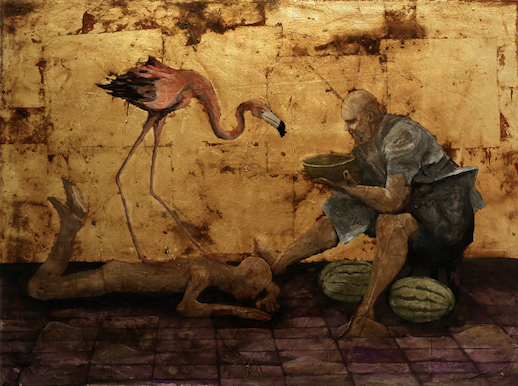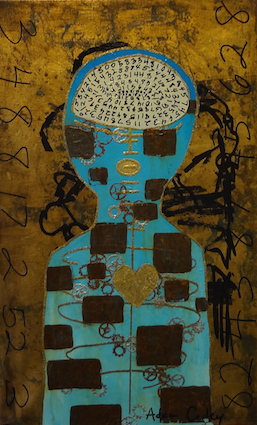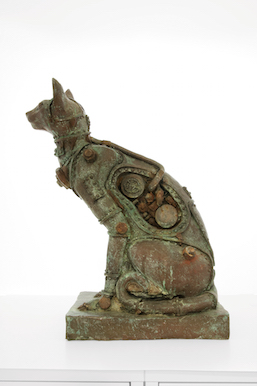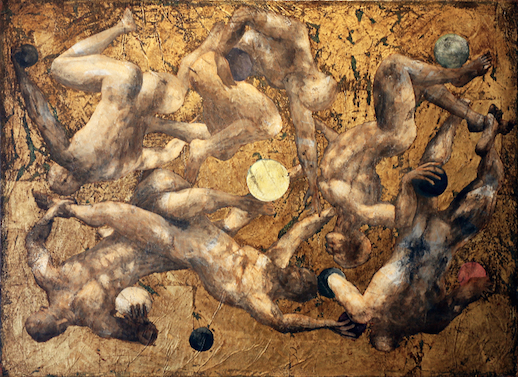The Passion of Adam Cooley
Osaka is known for its gritty, winding backstreets and it is here that Adam Cooley, an artist who has been exhibiting regularly in Japan for well over twenty years, agreed to show me his work and grant me an interview. I was initially drawn to the subtly textured surfaces of his paintings. Their brilliant gilded backgrounds are reminiscent of Nihonga painting, but their dense symbolism and Byzantine iconography can seem far from anything in his immediate Japanese surroundings. It is easier to find hints of Bosch or Egyptian symbolism. By speaking with the artist, I learned about his sophisticated technique that has evolved over two decades of painting and sculpting.
On my way to his studio, I walked through a narrow, brightly lit street filled with laughter and banter in an unmistakable Osaka dialect to an industrial neighborhood marked by warehouses and the buzz of an adjacent causeway. Cooley greeted me and showed me to a large room filled with makeshift lamps––he maintains that working deep into the night allows him more creative freedom. His workspace is well lit, but the walls were barely visible from where I sat. Though the workspace is intimidating, Cooley is certainly not. He is friendly and polite and dove into answering my questions with enthusiasm.

You’ve been settled in Osaka for quite a while, and I know you’ve been exhibiting here a long time, but I wonder if you could tell me how you started painting.
I started as a child and just never stopped. If there were crayons or markers, I would draw on any surface I could find. My mom put newspaper as far as I could reach on the walls, but I was incorrigible and anything I could draw on, color. or decorate was a fair game. When I couldn’t find any space I would just use my own body. My mother told me that once just before going out for an Easter dinner I had drawn zebra stripes all up and down my arms and legs with a permanent black marker. She went to take the marker away from me but being defiant as I was, I grabbed it, stuck it onto my face and dragged it across. So that’s how it started and I just kept getting more involved as I grew up.
Where did you first exhibit?
My first exhibition was at a gallery called The Blue Nile in Osaka. After that I did one at the Maronie Gallery in Kyoto, followed by a show at the Tokyo Metropolitan Art Museum. I’ve continued to exhibit every year since then.
Your recent work features a lot of gold-leaf gilding on the canvas, almost to the point that it becomes a recognizable and definitive feature of your work. Could you tell me a little bit about that?
I like gold color but it doesn’t really define my work. Actually, I don’t use a lot of gold leaf. It may look that way, but the process involves layering different metals such as copper and zinc and bronze powder to achieve a gold-like color––one that ends up being chemically reactive so that I can create the rust and a corrosive look that I love. I like transformation; the whole point of a lot of my work is transformation. What I’m depicting is usually figures in a state of transformation, but also the processes and techniques I use transform the physical paintings themselves.


Has your style stayed the same or has it evolved over time?
I think the style has changed, but the content of my work has basically been continuous. Maybe the way I’m expressing the forms is different because when I first starting exhibiting here, it was all primitive, very basic colors, very bright colors, a lot of carving into the panels, and the works were all three-dimensional in this sense. I seldom used canvas; I did use it a few times, but I would generally use chunks of wood-like panels. I would use epoxies and plastics and all kinds of things on the surface because I liked the texture and the dimension, but that was with very bright colors, very vivid colors, and that’s changed a lot. I think I went from extremely vivid to somewhat monotone. I love rust, and the processes I use in aging my paintings allow this to happen. I guess that’s why I’m very taken by Japanese pottery like the Shigaraki style, because it’s very primitive but with a great deal of process. It’s really the process that makes them what they are, unlike the Kiyomizu style of pottery, where it’s high detail but lacks that wild quality you find in Shigaraki pottery.
How has living in Japan influenced your work?
I think living in Japan has influenced my work, but it’s not necessarily a conscious influence. I’m not like a Japanophile. I mean, I live here and I like the culture and the art and the food and everything, but I wasn’t one of those people who thought, “I have to come to Japan because I feel intrinsically drawn to the culture.” I think the influence was more the result of osmosis. Even so, I still feel like it’s all about who’s looking at my work and where they are seeing it. One aspect of my painting that has changed drastically is my use of colors, which tend to be much more muted, and that might partially be from living here.

You had a solo exhibition in December at the Hankyu Umeda department store in Osaka. What kind of work did you show?
The title of the exhibition was Flower of Love. I like to create works for the space that I’m doing the exhibition in. If I’m painting just to paint, then that means the painting should be able stand on its own, but it doesn’t mean a painting looks good anywhere you put it. If you hang the Mona Lisa in your bathroom, it’s just not going to look right. When I have a certain gallery or museum that I’m working in, I like to know the space because that makes a big difference. For example, the angle from where people are going to see the painting, the distance, and so on––you have to calculate all that in. Hankyu has very nice lighting and a nice space so it’s very easy to paint for.
How many works were displayed and how did you come about choosing what to exhibit?
There were over one hundred new paintings and thirty new sculptures in the Hankyu exhibition, along with a dozen or so older, more recognizable works. For the majority of my recent shows, I leave the artwork selection to my art dealer. I prefer to just focus on the act of creation. I also have a more condensed version of the exhibition, called “Flower of Passion” at Gallery NAO (Nakamura Art Office) in Roppongi from January 18 to January 26, 2019. I will be creating a few new pieces for that exhibition.
Cooley and I concluded the interview around midnight. He showed me to the door, and as I made my way back through the solitary dark to the animated light of the city, he returned to his canvas and worked well into the dawn.
Finnegan Campbell
Finnegan Campbell



